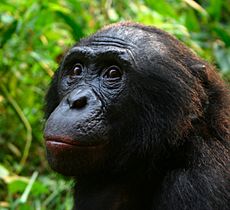Hominin facts for kids
Quick facts for kids Hominini |
|
|---|---|
 |
|
| Male bonobo | |
| Scientific classification | |
| Kingdom: | |
| Phylum: | |
| Class: | |
| Order: | |
| Superfamily: | |
| Family: | |
| Subfamily: | |
| Tribe: |
Hominini
|
The Hominini are a special group of primates. This group includes modern humans (Homo sapiens) and all of our direct ancestors. Think of them as our ancient family tree! Scientists believe this group started to branch off from other apes about five to eight million years ago. One very old fossil, called Sahelanthropus, is a key discovery from this time.
Sometimes, the Hominini group is also said to include chimpanzees and bonobos. These are two types of great apes that are very closely related to humans. When chimpanzees and bonobos are included, the "human" part of the family tree is called Hominina. This smaller group includes humans and our closest extinct relatives, but not chimpanzees or bonobos.
Contents
What are Hominini?
The word "Hominini" refers to a "tribe" in the scientific classification of animals. It's a way to group living things that are closely related. This tribe is part of a larger family called Hominidae, which includes all great apes like gorillas, orangutans, chimpanzees, bonobos, and humans.
The main thing that makes Hominini special is that they are the group that led to modern humans. This means they include all the species that walked upright on two legs, used tools, and developed bigger brains over millions of years.
Our Ancient Relatives
Scientists use fossils to learn about our ancient relatives. These fossils are like clues from the past. They help us understand how humans evolved. Here are some of the important groups and species that are part of the Hominini tribe:
The Panina Subtribe
This group includes the chimpanzees and bonobos. They are our closest living relatives in the animal kingdom.
- Pan (chimpanzees and bonobos)
The Hominina Subtribe
This is the group that includes humans and our direct ancestors. These are the species that are more closely related to us than to chimpanzees.
- Homo (humans): This genus includes modern humans (Homo sapiens) and earlier human species like Homo habilis and Homo erectus.
- †Paranthropus: These were robust, strong-jawed human relatives who lived in Africa. They had very large teeth and strong chewing muscles, suggesting they ate tough plant foods.
- †Australopithecus: This group includes famous fossils like "Lucy." Australopithecus species were early human relatives who walked upright. They lived in Africa millions of years ago.
- †Sahelanthropus: This is one of the oldest known members of the human family tree. Its fossils were found in Chad, Africa, and are about 6 to 7 million years old. It might be one of the first species to show signs of walking upright.
- †Orrorin: Another very early human relative, found in Kenya. Its fossils are about 6 million years old. Scientists study its leg bones to see if it walked on two legs.
- †Ardipithecus: This genus includes species like Ardipithecus ramidus, often called "Ardi." These early hominins lived in forests in Ethiopia and could climb trees but also walked upright on the ground.
- †Kenyanthropus: This species lived around 3.5 million years ago in Kenya. Its name means "flat-faced human from Kenya" because of its flat face.
The dagger symbol (†) next to a name means that the species or group is extinct, meaning they no longer exist today.
Human Evolution
The study of Hominini helps us understand human evolution. This is the scientific idea that humans developed over millions of years from earlier, ape-like ancestors. By studying fossils, tools, and other clues, scientists can piece together the story of how we became who we are today. It's a fascinating journey through time!
See also
 In Spanish: Homininis para niños
In Spanish: Homininis para niños

